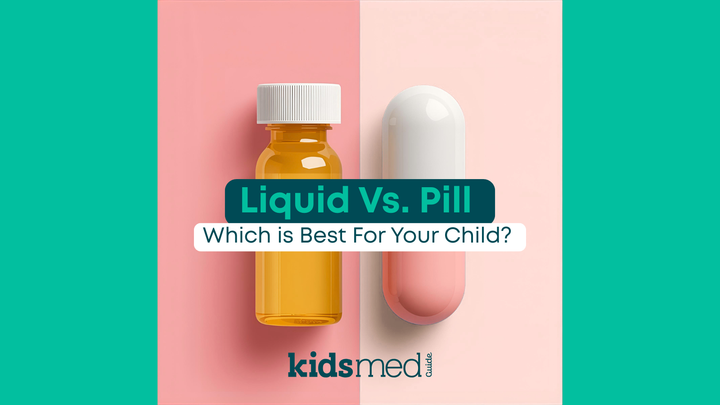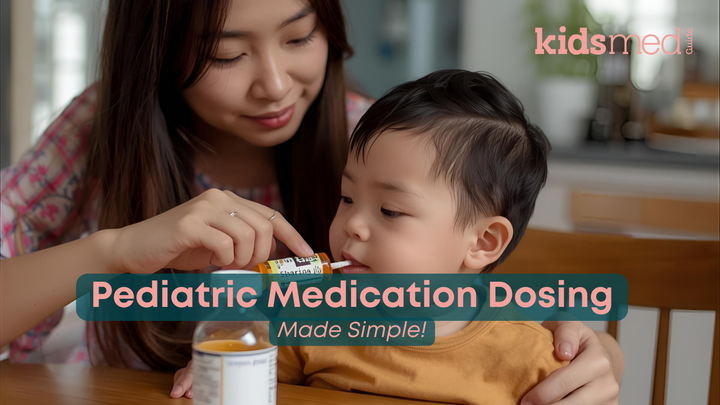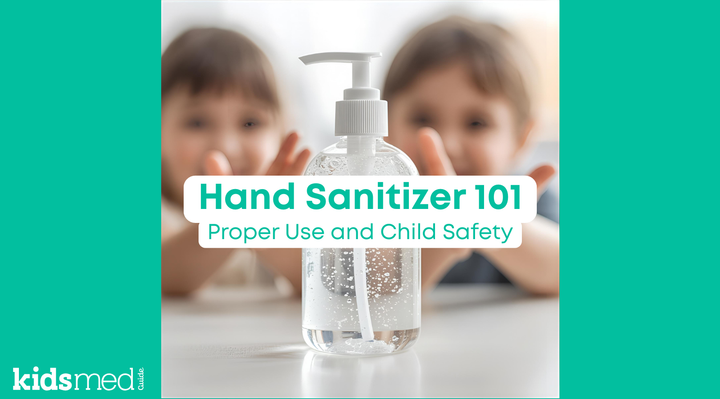Chewables, Liquids, or Meltaways? A Pharmacist’s Guide to Choosing Kids’ Meds

Medicine for kids comes in many different dosage forms. If you walk up and down the aisle of your local pharmacy, you’re likely to see shelf after shelf of what seems like the same product. It’s good to have options, but it can also be a bit confusing!
Kids are known for their strong preferences. When it comes to medicine (and food, drinks, and basically everything!), look, smell, and texture often matter almost as much as taste! If your toddler refuses bubblegum chewables but loves the taste of grape liquid, but also has a problem with the color purple… well, you’re not alone.
Why is it helpful to know the different options? Because sometimes your child needs to take medicine, and choosing the least contentious option can make things easier. Dealing with a stubborn, sick child who throws tantrums or resists medicine isn't easy. Having the right dosage form available may help the day go more smoothly!
What Are the Options?
Over-the-counter drugs and prescription medications are often available in various formulations, including (but not limited to!) liquids, chewable tablets, meltaways, sprinkle packets, tablets, and capsules.
Liquid
- Pros: Accepted by most children, easier to administer to babies and toddlers, often comes in a variety of flavors, and can measure virtually any dose needed
- Cons: Sticky, need an oral dosing syringe to measure accurately, some medicines have a strong or unpleasant taste that makes big doses hard to swallow
Chewable tablets
- Pros: Good for older preschoolers or children who can reliably chew and swallow, no dosing syringe needed, bottles are smaller and easier to pack and travel with, and some children prefer the "fun" part of the chew tab
- Cons: Can have a gritty or unpleasant aftertaste, texture may be an issue, fewer flavor options than liquid, less available doses (if your child's dose isn't an even increment of tablets or half tablets, it may not work for you)
Meltaways
- Pros: Good for older children who can't swallow a pill but don't want to do a liquid, some medicines may have a faster onset of action if they dissolve in the mouth instead of being swallowed
- Cons: Not as many drugs are available in meltaway formulation, they tend to crumble easily when being removed from packaging, they must be consumed quickly after being removed from foil pouches (can disintegrate in warm hands), not as many doses are available, so will likely only work for older kids on standard doses
Sprinkles
- Pros: Different kinds of sprinkle formulations are available, always read the package insert carefully, but sometimes these can be consumed in a favorite liquid or food; this is another option for when a child can't or won't take the liquid or tablet
- Cons: Not many drugs are available in sprinkle formulation, and administration instructions may vary widely from product to product
Tablets or capsules
- Pros: Traditional adult dosage form, almost every drug is available in a tablet or capsule form, no dosing syringe or special instructions needed, tablet or capsule forms are usually the least expensive option
- Cons: Can be difficult for children to swallow
Each has pros and cons depending on your child’s age, developmental stage, and ability to swallow or chew. Texture and feel also come into play. Some kids prefer a chew tablet to a liquid, for example, while others can’t stand the gritty feeling. Many of these dosage forms come in various flavors and colors, and you should also be able to find dye-free options if needed.
The good news is that any FDA-approved drug should be safe and effective when taken as instructed, so for healthy children, any available dosage form that is recommended for your child is a good choice!
If you’re feeling science-y...
(Aka nerdy) And you want to learn about some other things we think about, read on! This section is long, but it may be helpful food for thought.
If you’re like, "No thanks – skip that nerd stuff," scroll down to Pharmacist’s Take and Common Mistakes!
A bit more about choosing the correct dosage form: your options may be limited based on your child’s prescribed dose. Pediatric medicines are often dosed based on a child’s weight. And some drugs don’t have a wide dose “range” or a broad safety index that lets you round a calculated weight-based dose up or down to accommodate a tablet size, and still be a safe dose. Therefore, liquid might be your only option if an exact dose is needed!
For example, a typical acetaminophen dose for a child is 12.5 mg/kg/dose, up to a maximum dose of 500 mg/dose. However, a dose ranging from 10 to 15 mg/kg is usually acceptable, as long as the daily maximum dose is not exceeded (in this case, the maximum daily dose of acetaminophen is 75 mg/kg/DAY up to the adult maximum of 3,000 mg per DAY).
To illustrate this, if your child weighs 18 kg (about 40 lb), their recommended acetaminophen dose is 225 mg. That’s equal to 12.5 mg/kg. You can easily measure that dose if you’re giving acetaminophen liquid.
But say your child prefers chewable tablets! Chewtabs come in 80 mg tablets. Three tablets equal 240 mg. 240 mg / 18 kg = 13.3 mg/kg, which is well within the acceptable dose range of 10-15 mg/kg/dose. So 240 mg would also be a safe dose for your child, giving you the option of a liquid or a chewable tablet.
On the flip side, some medicines have what is known as a narrow therapeutic index or a narrow dosage range, meaning that a pediatric weight-calculated dose needs to be exact and can’t be rounded to a convenient dose. Exact doses may limit your options to use a tablet, capsule, or other pill-like dosage form, and force you to use a liquid so you can get the proper amount. This is common for young babies and certain prescription medications. Most over-the-counter children's products for older kids have dosing recommendations that conveniently round to standard doses, and the labels should clearly state that.
Inactive ingredients are also an important consideration. Some patients need to avoid sugar alcohols, for example, which may eliminate most liquid medications as an option. Or perhaps there is a dye allergy or sensitivity, or a gluten issue. Other children might have swallowing or feeding difficulties. You may have to work with your doctor or pharmacist to find a dosage form that is compatible with your child’s medical conditions.
Pharmacist’s Take
In general, for babies and toddlers, liquid is usually best. It’s the easiest dosage form to give to a young child, and you can achieve exact doses, which is important for the smallest patients.
For preschoolers, liquid, chewables, or meltaways may work. This really comes down to patient preference and what is available. Consider your family's needs - does everyone prefer liquid? Stick with the one formulation of ibuprofen and make it easier on yourself! This also helps to prevent mix-ups and errors.
Always check the concentration of the product in hand and reference the dosing chart on the bottle or your prescription label. Remember, most pediatric medicines are dosed based on a patient’s weight. Some are dosed based on age. Always ask your doctor or pharmacist if you’re unsure!
When measuring liquid doses, always use an oral dosing syringe—not a kitchen spoon.
If your child has any medical conditions, make sure to clarify with your healthcare provider. Some children on special diets may need to avoid certain inactive ingredients or dosage forms.
Common Mistakes
- Giving two forms of the same drug (e.g., ibuprofen liquid + chewables, or a multi-symptom cold product that contains acetaminophen + an independent dose of acetaminophen). Try not to buy multi-ingredient products or duplicate formulations of the same drug.
- Assuming age = ability (some 5-year-olds can swallow a tablet like a champ, while other 5-year-olds struggle with chewables!)
- Having multiple strengths of the same drug in the house. For example, cetirizine 2.5 mg chewable tabs and 5 mg chewable tabs. It’s a mix-up waiting to happen! I strongly advise against this.
Conclusion
The best medication dosage form is the one that will help your child feel better and is also something you, as a parent, can administer correctly. When in doubt, ask your pediatrician or pharmacist to show you the safest option!
Have you read this whole article, tried all the options, and still struggling to get your kid to take their medicine? Read our blogs: Getting Your Toddler to Take Yucky Medicine and What if Your Kid Spits Out Their Antibiotics?



